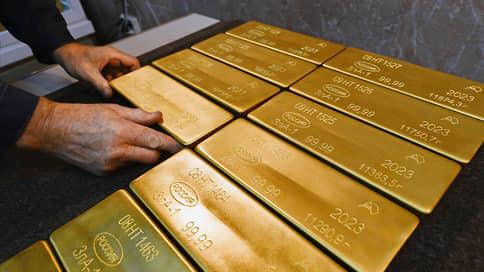Gold prices on the world market hit a six-month minimum
[ad_1]

Gold prices on the world market have reached a new six-month minimum. Over the past week they decreased by 3.7%, to $1.85 thousand per troy ounce. However, ruble prices for the precious metal remain close to the local maximum set in August. Global price dynamics do not scare away local investors who use gold as a hedging instrument in the face of further possible weakening of the ruble.
Firm bet
Last week, the price of gold on the world market, after a six-month break, dropped to $1.85 thousand per troy ounce. On Friday, according to Investing.com, quotes for the precious metal reached $1,852 per ounce, the lowest level since March 10. Over the week, the price of the precious metal fell by more than 3.7%.
International investors, like a year ago, are reducing investments in the precious metal amid harsh statements from Fed officials.
The American financial regulator began raising the key rate in the spring of 2022. Since then, by July of this year the rate was raised up to 5.25–5.5%. Following the September meeting, the American regulator, although saved rate at the same level, but did not rule out raising it before the end of the year. This led to an increase in US Treasury yields and reduced attractiveness of investing in gold.
Course support
The fall in world gold prices also has a negative impact on quotes for the precious metal on the Russian market. At the end of last week, the price of gold at trading on the Moscow Exchange decreased by 0.7%, to 5.83 thousand rubles/year. This is only 6.2% lower than the local maximum set in August, and almost 1.5 times higher than the values at the end of last year.
Price dynamics on the Russian market largely depend on the movement of the dollar exchange rate.
Last week, the American currency rose in price by 1.8% on the Russian market and the rate approached 98 rubles/$. This value is 3.7% below the local maximum set on August 14, but 40% higher than the values at the end of 2022.
Digital Broker analyst Daniil Bolotskikh draws attention to the fact that buying metal on the exchange has the lowest possible spread (compared to buying bars, investment coins or opening impersonal metal accounts.— “Kommersant”). An important role in this was played by the increase in liquidity in organized trading.
According to the Moscow Exchange, the total volume of transactions in precious metals in August amounted to 53.5 billion rubles, a record result for the entire trading period. Over eight months, the volume of trading in precious metals on the exchange amounted to 248 billion rubles, which is almost four times more than for the same period in 2022.
Consumer balancing
According to Sovcombank chief analyst Mikhail Vasiliev, by the end of the year gold quotes will be in the range of $1850–1900 per ounce. The rise in prices will be hampered by high yields on debt instruments against the backdrop of the Fed’s plans to raise rates. “Further price dynamics will depend not only on whether the rate will be increased again, but also on what the forecasts for further actions of the regulator will be,” notes portfolio manager of Alfa Capital Management Company Dmitry Scriabin.
At the same time, gold prices will be supported by expectations of a recession in the global economy.
“In favor of rising gold prices will remain purchases from consumers from China and India due to economic growth in these countries (by 5% and 7% this year), as well as purchases from central banks of various countries and other institutional investors against the backdrop of ongoing geopolitical contradictions,” says Mikhail Vasiliev.
Therefore, the currency diversification provided by the purchase of gold will remain the main catalyst for demand for it from local investors. In the fourth quarter, according to Mr. Vasiliev, the dollar exchange rate will remain around 98 rubles/$, and in 2024 the average rate may rise to 100 rubles/$. However, the risks are shifted towards a weaker ruble exchange rate. “There are no real measures to increase the supply of currency from exporters and reduce the demand for currency for imports and capital outflow,” explains Mr. Vasiliev.
[ad_2]
Source link





